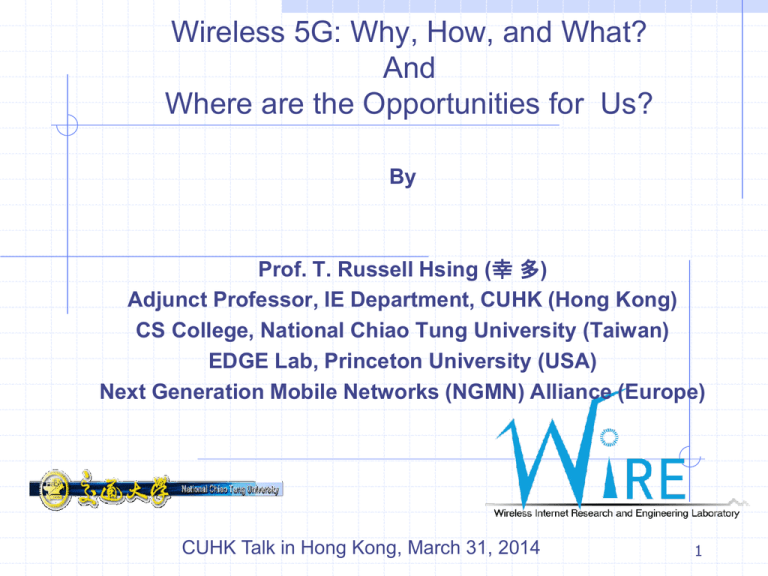RAMP: Reconfigurable Architecture and Mobility Platform
advertisement

Wireless 5G: Why, How, and What? And Where are the Opportunities for Us? By Prof. T. Russell Hsing (幸 多) Adjunct Professor, IE Department, CUHK (Hong Kong) CS College, National Chiao Tung University (Taiwan) EDGE Lab, Princeton University (USA) Next Generation Mobile Networks (NGMN) Alliance (Europe) CUHK Talk in Hong Kong, March 31, 2014 1 Wireless Evolution: Technologies, Services and Business Models Internet of Things Internet of Vehicles 5G Packet Networking 3G/4G Internet Smart Grid Internet Manufacturer Digitalization 2G/2.5G(Digital) Internet Manufacturer 1G (Analogy)Internet Manufacturer Source: Prof. Bo-Chao Cheng 2 All of The Following Seven Key Technologies for ICT Applications & Services Have Being Constantly Improved: • • • • • • • Communication Computing Storage Interface Sensor Actuator Software Algorithm Source: Dr. Adam Drobot 3 Wireless 5G: Why Now? • Currently 3G/ 4G could deliver unprecedented: Coverage Bandwidth Latency (not quite yet!) Reliability But 3G/4G could not fulfill many of the demanded emerging services and the new type of social media-enabled traffic pattern now • After iPhone was introduced in 2007, Steve Jobs’ Un-equilibrium Relationship • • • • occurs Immediately, i.e. Create a Market Gap of “Demands >> Supply” Traffic volumes will be increased at least 10~100 X from 2010 to 2020 Energy required will be needed by at least 10X, Need Green Energy Comm. Need “Best Effort” QoS >> ”Guaranteed” QoS Services for End-to-End Internet Networks, and Spectra Efficiency Need new Business Models and Spectra Efficiency Mar. 31, 2014 4 Wireless 5G: How? (i.e. Anticipated Features) • In the Near Future: Wireless 5G’s anticipated features Wireless 5G technologies should deliver explosive range & depth services: Personalization, Immediacy, Anticipation, Smart Data Pricing (SDP) Mar. 31, 2014 NFV/SDN-Based Mobility Management for Wireless 5G Cognitive Radio Network (CRN)-Based Spectrum Sharing Small Cell Networks (for huge data transactions applications) New Business Models: NaaS, DaaS, KaaS 5 Examples: Three Features and One Application Scenario for the Future Wireless 5G • Feature 1: Small Cell Networks • Feature 2: Smart Data Pricing • Feature 3: SDN-Based Mobility Management • Application Scenario: Internet of Vehicles (IoV) Mar. 31, 2014 6 Small Cells for LTE-A/B, IoT, 5G 1,2 3 Interference/ Coverage Network Operator Service for smarter apps. 4 Radio 3D Radio Resource Management POWER FLOW Frequency 1. More efficient traffic aggregate for smarter apps and services 2. More efficient QoS management for revenue based model 3. More adaptive network management for deploying to multiple areas (Wide, Hotspt, Indoors) and business cases (Metro, Residential, Enterprise) 4. More efficient spectrum/radio resource management to squeeze more capacity and value out of spectrum Source: Ming-Jye Sheng, EDGE Lab. Princeton University Why Smart Data Pricing? (1/3) Feb. 19, 2014, Source: Prof. Bo-Chao Cheng Why Smart Data Pricing? (2/3) • Bandwidth-Hungry Devices • Cloud Service • M2M Applications • Capacity-Hungry Application Network Congestion (Bursty Internet Traffic) Flat-Rate Pricing Source: http://www.potaroo.net/studies/1slash8/1slash8.html Hard Solution: Network Deployment Soft Solution: Pricing Strategy • Usage-Based since 2008 • ApplicationBased Cons 1. What Time 2. Traffic Condition 3. Network Resource Mar. 31, 2014 Source: Dr. Gi-Ren Liu & Prof. Phone Lin 9 Applications for Smart Data Pricing (3/3) Time & Traffic Dependent Pricing: • Peak Load Pricing • Off-Peak Discounting Change of User Incentives for Internet Access Time- & Traffic-Shifting Data Demand Pros: • Ease Network Congestion • Flatten Traffic Burst Cons: • Network Neutrality • Hurt Demand ? • TUBE by Chiang's lab, a solution, allows smartphone users to pay for their network usage based on what time they download videos and other data. • The UI on an iPhone provides users with information on pricing and usage history Example: TUBE Solution by Mung Chiang’s LAB, PRINCETON to encourage them to use their phone during https://www.princeton.edu/engine off-peak hours. ering/news/archive/?id=5103 Mar. 31, 2014 Source: Dr. Gi-Ren Liu & Prof. Phone Lin 10 What is SDN-Based Mobility Management* Incompatible wireless systems will still coexist in the future In SDN-based mobility management Core network and radio network are reconfigurable Both network and mobile node can choose their prefer mobility management protocols *Jyh-Cheng Chen, et. al, “Reconfigurable architecture and mobility management for next-generation wireless IP networks,” IEEE Transactions on Wireless Communications, August 2007 *Jyh-Cheng Chen, et. al, "RAMP: reconfigurable architecture and mobility platform“. IEEE GLOBECOM 2005 11 Why SDN-based Mobility Management The network can incorporate different mobility protocols with different features. Mobile node can change its mobility protocol at anytime when moving into different networks. Can incorporate new protocols easily Can integrate heterogeneous networks easily Provide guaranteed QoS for end-to-end Internet Mar. 31, 2014, Source: Prof. Jyh-Cheng Chen, NCTU 12 Internet of Vehicles: Vehicular Telematics Applications (1/2) Safety/Auto Services Navigation & Mobility Infotainment & E-commerce V2I Communication V2V Communication GPS Telematics Enabled Vehicles Connected Vehicle Services Enabling Trends •Safety/Auto services •Smartphone Platforms •Driver Safety and Security •Vehicle Maintenance •App Store Business Model •Tethering for OBU • Navigation & Mobility •OBU and Passenger Entertainment Systems •Traffic, ETA, POI, Localized Searches •Tolls and Parking •Embedded wireless and sensors •Smartphone integration with improved HMI •Infotainment & E-Commerce •Infrastructure •Digital Content •Social Networking •Vehicle Infrastructure Integration (Future) •Cloud based delivery 13 Internet of Vehicles: High Speed Rail (HSR) (2/2) Train Control System Data transmission Required high reliability and security Communication System Voice communication Train crews and operation center Data transmission Diagnostics, CCTV or etc. Passenger service Wi-Fi connecting to Internet Acela Express (Amtrak, USA) TGV (SCNF, France) Tokaido Shinkansen (JRC, Japan) Wireless 5G: What ? (i.e. Our Objectives [PASS]) Performability full connectivity, coverage, bandwidth, latency, green energy Adaptivity (for future traffic volumes) SDP, CRN-based spectrum sharing & NFV/SDN-based mobility management, context awareness Scalability number nodes and traffic volumes Security confidentiality, integrity, availability, reliability, privacy and trust Mar. 31, 2014 Technology Trend (1/2): Cloud-based Networking >> Fog-based Networking • Pushing processing and storage into the “cloud” has been a key trend in networking and distributed systems in the past decade. In the next wave of technology advance, the cloud is now descending to be diffused among the client devices, often with mobility too: the cloud is becoming “fog.” • Fog Networking combines the study of mobile communications, micro-clouds, distributed systems, and consumer big data into an exciting new area March, 2014, Source: Prof. Mung Chiang, Princeton University 16 Technology Trend (2/2): Cloud-based Networking >> Fog-based Networking Examples of recent Fog Networking R&D activities range from RF and physical layer to application layers: Client-driven distributed beam forming Client-side HetNets control Client-defined cloud storage systems Efficient distributed storage at the edge micro-clusters Smart Data Pricing implemented through client-side control • Crowd-sourced LTE network state inference • • • • • March, 2014, Source: Prof. Mung Chiang, Princeton University 17 Wireless 5G: What? (i.e. Enabling Services Creation) -Applications- & Services- Driven Research for Services Creation Based on “Cloud & Fog Computing” Platform to develop Mobile Applications which are ubiquitous, scalable, reliable and cost effective Mar. 31, 2014 Internet of Vehicles (IoV) and Healthcare Services Privacy-preserving secured communications Green Communications for Future Mobile Wireless Technology and Services Provision Small Data Pricing Applications ISP, Content provider, Consumer Win-Win-Win ecosystem New Business Models: NaaS,, DaaS, and KaaS 18





